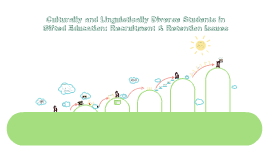Background template
Transcript: 1 - Besnoy, K. (2012). 'Culturally Diverse Gifted', http: //youtu.be/XBhpdmHFbAc 2 - Davidson Institute. (2006). State mandates for gifted programs as of 2006. Retrieved May 19, 2013 from http: //www.gt-cybersource.org/StatePolicy.aspx?NavID=4_0 3- Davis, G. A., & Rimm, S. B. (2003). Education of the gifted and talented. Boston: Allyn & Bacon. 4 - Ford, D. Y, & Grantham, T C. (2003). Providing access for culturally diverse gifted students: From deficit to dynamic thinking. Theory Into Practice, 42, 217-225. 5 - Ford, D. Y., Grantham, T. C., & Whiting, G. W. (2008). Culturally and linguistically diverse students in gifted education: Recruitment and retention issues. Exceptional Children, 74(3), 289-306. 6 - VanTassel-Baska, J., Lange, R.E., & Crammond, B. (2010). International Giftedness. http: //www.ctd.northwestern.edu/resources/displayArticle/?id=128 7 - WISE Qatar, (2012). 'Gifted Students', http: //youtu.be/LvrBUzTDYTg Linguistic - Using English-based assessments can lead to erroneous conclusions. Cultural - Traditional customs and gender roles differ between groups. Economic - The effects of poverty lead to a focus on survival more than education. Culturally and Linguistically Diverse Students in Gifted Education: Recruitment & Retention Issues Do we hold negative, stereotypical, or counterproductive views as defined by Ford and Grantham? WE ARE TEACHERS And We Help To Shape The Students’ Futures! FORGET about IQ- Alternative Assessments 5 Asian American students are NOT! Provide enrichment activities to students who are perceived "not ready" for gifted programs. 5 These students deserve a chance to shine and should be provided with support and opportunities to demonstrate their giftedness. "We suggest that deficit thinking and the use of traditional tests (especially IQ tests) and lack of teacher referral of CLD students for gifted education screening and placement are the primary contributing factors to underrepresentation." Bias 5 C) the burden rests with (or within) the student (e.g., he/she is cognitively inferior or "culturally deprived") Testing & Assessment Issues "The bright and the hungry ... are crucial to our success" Strengths Themes References Terminology 4 Make adjustments to your lessons with special attention to vocabulary acquisition. 1. Background/Bias stop students from being identified 2. Standardized test scores stop referrals 3. Lack of training in cultural diversity as well as gifted education 4. Lack of communication with cultural diverse parents whether intentional or unintentional 5. Policies & procedures that are both indefensible and have a negative impact on CLD students 6. Static definitions & theories of gifted that give little consideration to cultural differences Culturally diverse students are those that may come from different regions and races, social backgrounds, and may also be economically disadvantaged. English may even be their second language. Retention 2, 3 IQ or intelligence quotient is a general assessment of your ability to think and reason. Your IQ score is actually an indication of how you compare in this ability with the majority of people in your age group. A rating of 100, for example, means that, as compared to the majority of other people in your age group, you have a normal rate of intelligence. Most psychologists consider those falling in the range of 95-105 as having a normal or average IQ. Since it is difficult to pinpoint with absolute accuracy, your actual IQ may vary 5 points either way from your test score. In addition, there are many factors that may affect your scoring. If you are tired, ill or distracted, your score may be affected. Finally, there are many abilities which are not measured by IQ testing. For example, IQ does not measure musical talent, manual dexterity, or a variety of other abilities. However, IQ testing does give you an important indication of your ability to think, reason and solve problems. This is critical to your success in life. The IQ Test is comprised of 15 questions. Be sure to view your results at the end of this test. Do not begin until you are instructed to do so. You will have 3 minutes. Good luck! Reasons for Poor Test Performance of CLD students: Raven's Progressive Matrices 5 Become aware of teacher bias. Why do educators serve less Hispanic, Black, and Aboriginal students than White? (A) the burden rests within the test (e.g., test bias); 6 Limitations IQ Test Instructions This is the main reason educators should become more aware of their students who may be underserved and underrepresented. "As of 2002, Asian American students represented 4.42% of students in U.S. schools but 7.64% of those in gifted education" - No clear suggestions as to how to retain students in Gifted education. – Also does not compare states among one another. Ideally: Naglieri Non-Verbal Ability Test & Raven's Progressive Matrices Assess students from the perspective of individual learning styles. Currently: The first step is

















